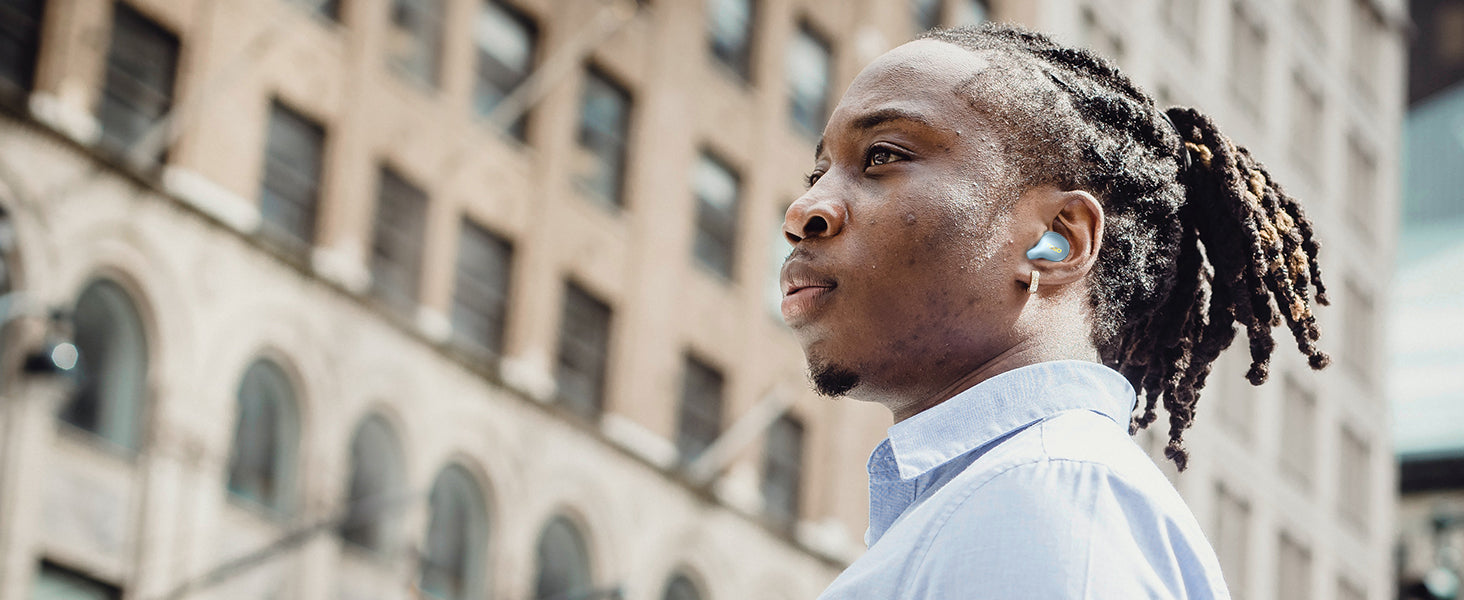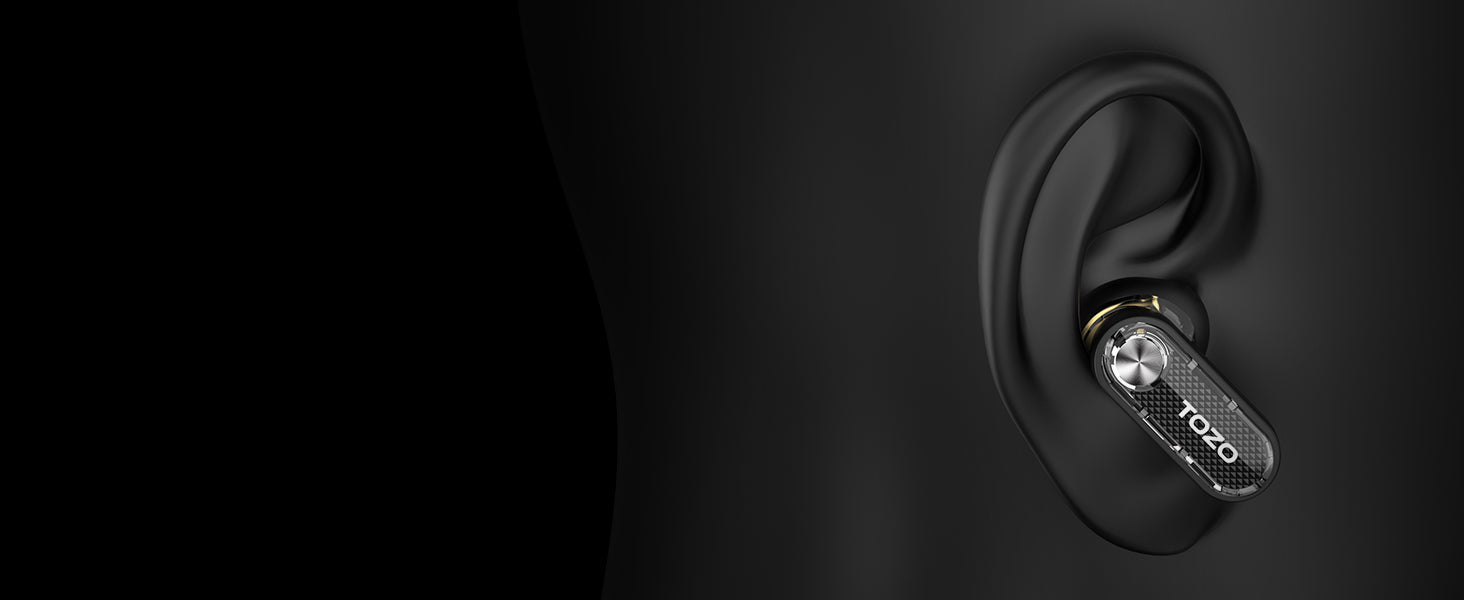¿Buscas los auriculares perfectos para escuchar música mientras viajas, en casa o en el estudio? Al elegirlos , considera si necesitas auriculares abiertos o cerrados. Estos dos tipos ofrecen experiencias auditivas muy diferentes, lo que los hace adecuados para un uso específico.
Comprender estas diferencias es fundamental para tomar una buena decisión. Este artículo compara exhaustivamente los auriculares abiertos y cerrados para ayudarte a comprenderlos mejor y decidir cuál es el mejor para ti.
¿Qué son los auriculares abiertos?
Los auriculares abiertos tienen un diseño amplio y ventilado. Sus auriculares no suelen sujetarse a la diadema o tienen pequeños orificios que permiten el paso del aire de la parte trasera del altavoz. El sonido se filtra por los auriculares y se siente como si te rodeara, ofreciendo un sonido más natural y expansivo. Debido a este sonido, muchos audiófilos e ingenieros de sonido los prefieren para la escucha crítica.
Sin embargo, no garantizan el aislamiento. Su parte trasera abierta permite que el ruido ambiental entre fácilmente en los auriculares y se mezcle con lo que escuchas. Además, quienes te rodean pueden oír lo que escuchas, lo que a veces puede resultar molesto. Por estas razones, muchas personas los consideran inadecuados para entornos ruidosos o concurridos.

¿Qué son los auriculares cerrados?
Como su nombre indica, los auriculares cerrados tienen almohadillas selladas que retienen el sonido y bloquean el ruido externo. Enfocan el sonido directamente en tus oídos, brindándote una experiencia auditiva más aislada. Quienes te rodean no pueden oír lo que escuchas, y tú tampoco puedes oír su ruido.
Además, sus partes traseras cerradas mejoran la respuesta de graves, ofreciendo graves potentes e impactantes. Sin embargo, al usarlos durante un período prolongado, el entorno sellado puede generar presión y reducir la ventilación en los oídos, lo que provoca una ligera sensación de calor.

Diferencias entre auriculares abiertos y cerrados
Escenario sonoro
Los auriculares abiertos son excelentes para crear un sonido amplio e inmersivo que permite disfrutar de la sensación de espacio y direccionalidad del sonido. Esto los hace ideales para géneros como la música clásica o tareas como la mezcla y masterización, donde se requiere precisión espacial.
Por el contrario, los auriculares cerrados ofrecen un sonido más profundo y directo con una escena sonora más estrecha. Esta capacidad de focalización del sonido es excelente para géneros como el hip-hop o la música electrónica, que se benefician de unos graves mejorados y una experiencia de audio concentrada.
Respuesta de frecuencia
Gracias a su mejor flujo de aire, que resulta en una representación más precisa de las frecuencias medias y altas, los auriculares abiertos ofrecen una respuesta de frecuencia de sonido más equilibrada y natural. Por lo tanto, muchos los consideran adecuados para la escucha crítica y la producción de audio.
Los auriculares cerrados suelen enfatizar las frecuencias graves, potenciando el impacto de los sonidos más graves. Si bien esto puede ser agradable para música con muchos graves, puede afectar ligeramente el sonido general, haciéndolo menos natural en comparación con los auriculares abiertos.
Aislamiento de ruido
Una de las diferencias más significativas entre los auriculares abiertos y los cerrados es el aislamiento del ruido. Los auriculares cerrados ofrecen el mejor aislamiento, ya que su diseño bloquea eficazmente el ruido externo, lo que garantiza que puedas disfrutar de tu música sin interrupciones.
Por otro lado, los auriculares abiertos ofrecen poco o ningún aislamiento del ruido. El ruido ambiental puede penetrar fácilmente en los auriculares e interrumpir la escucha, lo que los hace menos adecuados para espacios públicos o ruidosos.
Comodidad
Al usar auriculares, la comodidad depende de las preferencias personales y del modelo específico, pero, en general, la mayoría de las personas consideran que los auriculares abiertos son más cómodos para largas sesiones de escucha. Su diseño abierto permite que el aire fluya libremente dentro y fuera del auricular, lo que reduce la acumulación de calor y evita que los oídos se sientan apretados.
Por el contrario, los auriculares cerrados pueden causar fatiga auditiva si se usan durante sesiones prolongadas. El sellado hermético restringe el flujo de aire, lo que genera presión y acumulación de calor, lo que puede provocar una mayor sensación de calor y presión en los oídos. Sin embargo, muchos fabricantes de modelos cerrados de alta gama buscan ofrecer comodidad con almohadillas suaves y materiales ligeros.
Fuga
Los auriculares abiertos son conocidos por sus fugas de sonido. Al usarlos en espacios compartidos, otros pueden oír lo que escuchas, privándote de privacidad y causando molestias innecesarias.
Los auriculares cerrados mantienen el sonido dentro de los auriculares, lo que impide que quienes te rodean escuchen lo que escuchas. Te permiten escuchar música o ver vídeos cómodamente en espacios compartidos sin molestar a los demás.
Casos de uso
Los auriculares abiertos son ideales para uso doméstico, estudio y lugares donde no hay problemas de fugas de sonido. Su experiencia auditiva natural los hace ideales para escuchas exigentes y trabajos de audio profesional.
Debido a su excelente aislamiento de ruido y capacidades de respuesta de graves, los auriculares cerrados son perfectos para viajar, viajar y escuchar música en general, especialmente en entornos ruidosos.
Precio
Si bien hay auriculares abiertos y cerrados disponibles en una amplia gama de precios, desde opciones económicas hasta modelos de alta gama, tienden a ser un poco más caros, en particular en el mercado audiófilo de alta gama, debido a su diseño especializado y su uso en entornos profesionales.
Durabilidad
Los auriculares cerrados suelen ser más duraderos gracias a su sólida construcción. Su diseño sellado impide que el polvo o la humedad lleguen a las partes sensibles, lo que les permite soportar un manejo más brusco y una mayor duración.
Aunque suelen estar fabricados con materiales de alta calidad, los auriculares abiertos pueden ser menos duraderos. Su parte trasera abierta permite la entrada de humedad y polvo, dañando las piezas sensibles, lo que los hace más adecuados para su uso en interiores, donde son menos propensos a sufrir daños.
¿Debería elegir auriculares abiertos o cerrados?
La elección entre auriculares abiertos o cerrados depende en última instancia de su entorno de escucha, sus hábitos y sus preferencias.
Si escuchas música con frecuencia en entornos ruidosos o necesitas auriculares para desplazarte, los auriculares cerrados pueden ser la mejor opción. Ofrecen un aislamiento de ruido superior y una respuesta de graves mejorada, lo que te permite disfrutar de tu música o podcasts sin interferencias externas.
Si sueles estar en un espacio tranquilo, como en casa o en un estudio, y valoras un audio preciso con una escena sonora amplia, te recomendamos probar los auriculares abiertos. Ofrecen una experiencia auditiva más natural, lo que los hace perfectos para la escucha crítica y la producción musical.
Preguntas frecuentes sobre auriculares abiertos y cerrados
¿Puedo utilizar auriculares abiertos en público?
Sí, puedes usar auriculares abiertos en público. Sin embargo, debido a la importante pérdida de sonido, debes tener en cuenta tu entorno de escucha. Si no te importa que otros escuchen lo que escuchas y no quieres molestarlos, puedes usarlos cómodamente.
¿Los auriculares cerrados son siempre mejores para la cancelación de ruido?
No. Aunque los auriculares cerrados son excelentes para el aislamiento pasivo del ruido, no todos los modelos cuentan con cancelación activa de ruido (ANC) . La ANC permite que los auriculares cerrados cancelen electrónicamente el ruido de fondo y ambiental. Por lo tanto, conviene comprobar si un modelo cerrado en particular cuenta con ANC.
¿Puedo utilizar auriculares abiertos para jugar?
Puedes usar auriculares abiertos para jugar, especialmente en entornos silenciosos. La mayoría de los gamers los prefieren por su sonido más natural y comodidad durante largos periodos de uso.





























